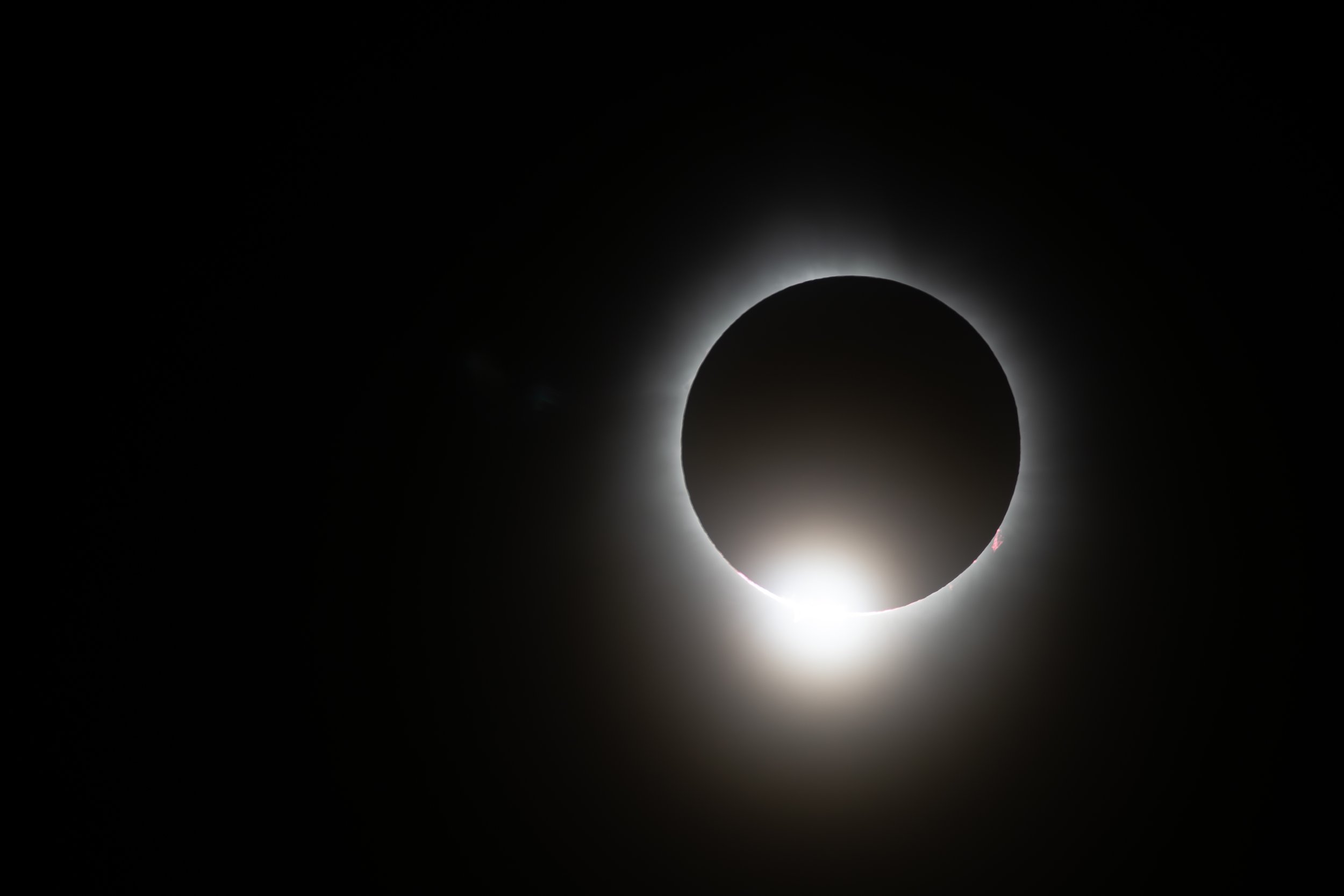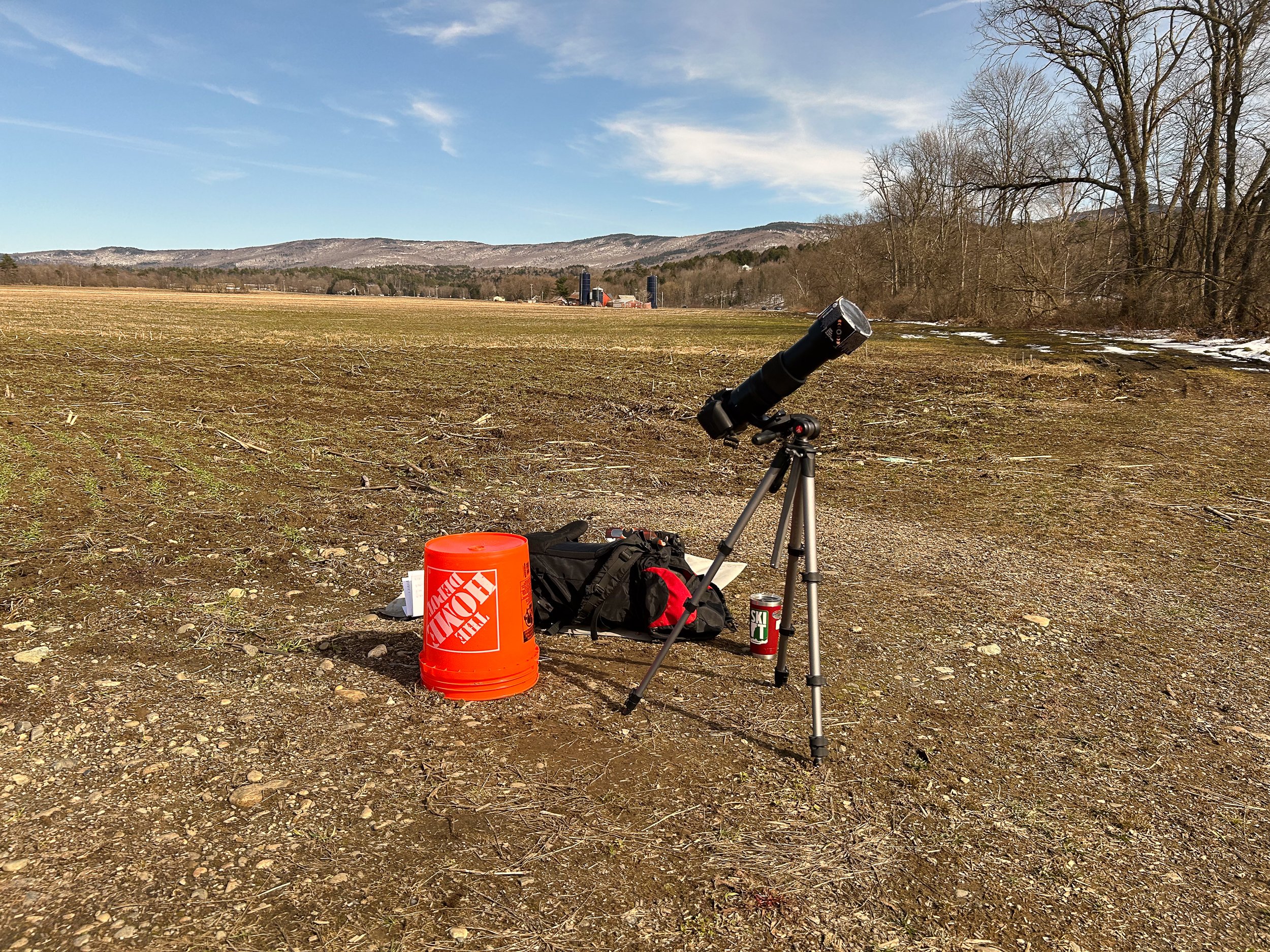Total Solar Eclipse 2024
I’m fortunate enough to live on the path of totality for the eclipse that occurred on 08APR24. It was the first time I have experienced a total eclipse and I want to see another.
Preparation. I realized that we live in the totality path early last year. Immediately researched eclipse glasses and bought some on line from https://www.eclipseglasses.com/. In retrospect I wish I had brought the hand held cards instead of the glasses. Spent most of my time during the partial phases taking photos (more on this in a bit) with occasional glances up at the sun. I think a hand held card would have been easier to use than the glasses (especially since I wear glasses).
Location and the Weather. I was pretty indifferent about trying to photograph the eclipse because historically there is a 70% chance that it will be cloudy on April 8th in northern Vermont. That all changed about two weeks before the event. Long range weather models ( https://www.tropicaltidbits.com/analysis/models ) started to consolidate towards clear skies on the 8th. Went to the local camera store to get a filter and they were sold out of 95mm solar filters. I had waited too long. So off I went to B&H photo’s website and had a filter shipped overnight ( https://www.bhphotovideo.com/c/product/1319799-REG/daystar_filters_ulf90_90mm_universal_lens_filter.html ).
Now that I had a filter, the next step was to figure out where to go. I knew I didn’t want to be with a crowd of people and also didn’t want to spend a lot of time in the car after the eclipse. I had read about the 360 degree sunset/sunrise and wanted a good location to try to video the effect.
We live on a side road off Route 100 in Stowe, Vermont and there are corn fields near our house. At this time of year, it is probably more accurate to describe them as mud fields. It is about a ten minute walk from the house. There was a relatively dry spot near the middle surrounded by lots of mud. Perfect.
The morning of the 8th dawned with crystal clear blue skies. I made coffee and went outside to take some practice shots with the filter. What are those thin clouds on the western horizon??? Back to the computer to see that the clouds working into the area were associated with a cold front arrival that was ahead of schedule.
Spent the next couple hours alternating between watching the approaching clouds, the IR satellite imagery, and figuring out where I could go to the northeast if the clouds kept building. There are lots of corn fields northeast of us and I targeted a couple as possibilities. Was wishing I had done a little more location scouting.
Decided to make my location decision at 1pm. I think I would have jumped in the car if I had an alternate site scouted. The sky was still crystal clear to the northeast and there was just a very thin layer of cirrus clouds directly above me and to the west. Seemed like the clouds weren’t going to thicken much more in the next few hours so I made the decision to stay put. Rationalized that the thin clouds might make the sunrise/sunset effect even better.
Photographing the Eclipse. I did a lot of research on line leading up to April 8th and came up with a game plan for photographing the eclipse. Used a Canon Rebel T8i set to RAW, my Sigma 150-600 C zoom lens, and a wildly inadequate tripod. I connected my camera to the Canon CameraConnect app on my iPhone to control the camera. I have used the app in the past to photograph fireworks and it is very easy to adjust the camera settings using the app.
These were the two most useful webpages I found:
The Plan:
Take photos every few minutes from the beginning of the eclipse until totality with various f-stop/shutter speed combinations with a fixed ISO of 200 (more on this below).
Take the filter off just before totality to capture the diamond ring. Take a few stills to figure out shutter speed, switch the camera to video and make a short video while I used my iPhone to make a 360-degree video.
Switch the camera back to stills and take more photos with various f-stop/shutter speed combinations.
Set an alarm on my phone for 1 minute before the end of totality so that I could get ready for the second diamond ring and put the filter back on the end of the lens.
Capture the second diamond ring and put the filter back on the camera
Take photos every few minutes until the end of the eclipse with various f-stop/shutter speed combinations.
What Actually Happened: Left the house to walk to my location around 1:30pm. Got there, set up, and took a few more test shots of the sun. I brought two other lenses and two extra camera batteries just in case. Turns out bringing the two fully charged extra batteries as a good idea because I massively underestimated how much power it takes to run the camera using the app. Fireworks shows typically last 30 minutes max. I used two full batteries and part of the third photographing the eclipse. By the end of the day my phone was down to 11%.
The eclipse started and I took photos every few minutes. I ended setting the camera to f6.3 and left it there for the entire eclipse (one less variable). I had planned to use ISO200 based on my research but ended up using ISO400 for most of my shots (including all of the totality).
A few minutes before totality there was a noticeable drop in temperature. Pulled my hoodie out of my backpack and wasted way too much time putting it on. Kept taking photos through the eclipse filter of the tiny disappearing sliver of the sun and missed the initial diamond ring. Good thing there are two! Pulled the filter off, adjusted the shutter speed from 1/50 to 1/2500 and took a couple photos.
Completely forgot to start the video with the camera and made the 360-degree video with my phone:
Got sucked in and just sat there looking around with my mouth open. The alarm on my phone went off telling me it was going to end in a minute. Uh oh. I should take more photos. Very quickly took about 20 photos varying the shutter speed between 1/25 and 1/4000 (f6.3 ISO400). It’s a really good thing I set that one minute warning alarm or I would not have taken any photos other than the couple at the beginning.
Put the solar filter back on and took more photos every couple of minutes until the eclipse ended. Packed up and walked back to the house.
Words and photos cannot fully describe the sun being a black glowing dot in the sky
Notes for My Future Self:
Wear sunscreen. My face looked like a tomato by the end of the day. It never occurred to me that the sun is still really strong during an eclipse
Get handheld eclipse viewers instead of glasses
Bring a watch so that I have a better countdown for totality. I thought I would be able to use the clock on my phone.
Bring a layer of clothes that is easy to put on when the temperature drops.
Bring extra batteries! Don’t want to miss a shot because of a dead battery. I went through two and a half batteries. If it was colder I expect I would have needed 4. I should have also brought the portable charger for my phone.
Need a separate device to control the camera. I used the app on my phone and kept having to switch out of it to do phone stuff.
Bring a second camera with a shorter lens and someone to take photos with it during the totality. Totality doesn’t last very long and it would be great to have more landscape type shots of the black glowing dot in the sky.
Be flexible about where you will watch the eclipse. Scout out several locations near your target so you can move if needed due to cloud cover. We had high thin clouds which were not an issue, but if the cloud cover had arrived a couple hours earlier and thickened up it would have been a very different experience. Had I pre-scouted a location to the northeast I would have 100% moved.
Use a heavy duty solid tripod. The one I used was not solid enough for the weight of the lens. I ended up just using the top two extensions to reduce windage/vibration.
Get a solar eclipse timer app with an audio countdown. A friend used this one and recommends it:
Bring snacks! In retrospect a small table and a charcuterie board would have been awesome.
Link for seeing future eclipses: https://www.timeanddate.com/eclipse/list.html
Are we sure it was the moon passing in front of the sun and not the Death Star?????????
Thanks for reading my post. Click on any of the photos if you are interested in getting a print.





